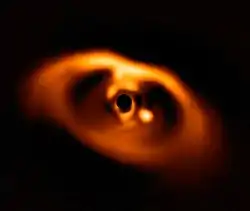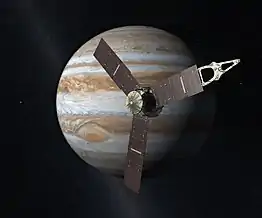Kepler-1638b
Kepler-1638 b is an exoplanet in orbit of its star, Kepler-1638, located in the constellation Cygnus. The planet is a super-Earth, with a radius of 1.87+0.33
−0.22 R⊕, and a mass of 4.16 Earths. It has an orbit of 259.337±0.013 days in its system's habitable zone and orbits 0.745 AU from its star. It is the farthest potentially habitable exoplanet discovered, at approximately 2,867.000 light-years (879.0262 pc) from Earth.[1][2][3][4][5]
| Discovery | |
|---|---|
| Discovered by | Ames Research Center |
| Discovery date | 2016 |
| Transit | |
| Orbital characteristics | |
| 259.337±0.013 d | |
| Star | Kepler-1638 |
| Physical characteristics | |
Mean radius | 1.87+0.33 −0.22 R⊕ |
References
- "Kepler-1638 b". NASA Exoplanet Science Institute. 10 May 2016. Retrieved 11 May 2016.
- Morton, Timothy D.; Bryson, Stephen T.; Coughlin, Jeffrey L.; Rowe, Jason F.; Ravichandran, Ganesh; et al. (May 2016). "False Positive Probabilities for all Kepler Objects of Interest: 1284 Newly Validated Planets and 428 Likely False Positives". The Astrophysical Journal. 822 (2). arXiv:1605.02825. Bibcode:2016ApJ...822...86M. doi:10.3847/0004-637X/822/2/86.
- Burgess, Matt (11 May 2016). "Nasa's Kepler telescope just found 1,284 exoplanets". Wired. Retrieved 21 June 2016.
- "Exoplanet-catalog". Exoplanet Exploration: Planets Beyond our Solar System. Retrieved 24 January 2021.
- May 2016, Mike Wall 11. "1st Alien Earth Still Elusive Despite Huge Exoplanet Haul". Space.com. Retrieved 24 January 2021.
This article is issued from Wikipedia. The text is licensed under Creative Commons - Attribution - Sharealike. Additional terms may apply for the media files.



